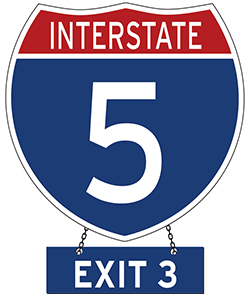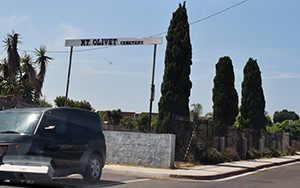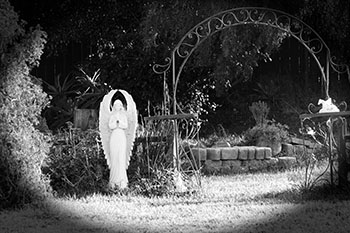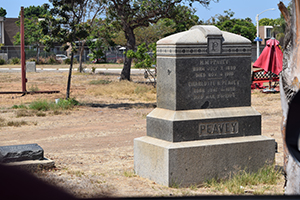 Schlepping and Schmoozing along the Interstate 5
Schlepping and Schmoozing along the Interstate 5
Chapter 4, Exit 3, Mount Olivet Cemetery, Nestor
From Exit 3 (SR 905 East/ Tocayo Avenue): Take Tocayo Avenue exit and follow signs for Oro Vista Road; Continue onto Tocayo Avenue; turn right onto Hollister Street; Turn left onto Iris Avenue. Mount Olivet Cemetery is on the left.
 Another reason why we’re confident that “there is a Jewish story everywhere” is the widespread influence of the Jewish Bible (Tanakh), which includes the five books of the Torah, as well as Nevi’im (Prophets) and Ketuvim (Writings).
Another reason why we’re confident that “there is a Jewish story everywhere” is the widespread influence of the Jewish Bible (Tanakh), which includes the five books of the Torah, as well as Nevi’im (Prophets) and Ketuvim (Writings).
In Nestor, a neighborhood of San Diego northwest of San Ysidro, a small, two-acre, formerly abandoned burial grounds, recently undergoing restoration, is named the Mt. Olivet Cemetery. Located at 2127 Iris Street, it is so small, it sometimes is called Mount Oliveito Cemetery. It is surrounded by single-family residences.

“Mt. Olivet” is a synonym for the Mount of Olives, a location in Jerusalem that is mentioned in both Hebrew and Christian literature.
A large Jewish cemetery, with some 150,000 burials, is located at the Mount of Olives in Israel in response to the traditional belief that when the dead are resurrected, the process will begin there. Former Israeli Prime Minister Menachem Begin chose to be buried there rather than on Mount Herzl where many of the Jewish State’s other prominent political leaders are buried. The Mount of Olives is higher than the Temple Mount, so it provides visitors with a view of the sacred area now occupied by the Western Wall, Dome of the Rock, and the Al Aqsa Mosque.
In Hebrew Scriptures, the Mount of Olives is the place to which King David, barefoot and weeping, fled when his son Absalom led an insurrection against him. It is also the place where David’s son, King Solomon, permitted his foreign wives to erect shrines to their polytheistic gods. Centuries later, King Josiah, a religious reformer, destroyed every remnant of these shrines. The Prophets Ezekiel and Zechariah both forecast the Lord’s Presence would descend upon the Mount of Olives – in Ezekiel’s prophecy, to restore the destroyed City of Jerusalem, and in Zechariah’s to split the mountain in half, creating a new valley, and bring about His kingdom on earth.

In Christian Scriptures, the Mount of Olives is a central location. It was from there, according to the Acts of the Apostles that Jesus, 40 days after his resurrection, ascended to heaven. During Jesus’ mortal lifetime, while riding a colt to Jerusalem, he stopped at the Mount of Olives and wept, knowing that the city would be destroyed. Later, in the days leading to his crucifixion, he told his apostles that following his death at the hands of the Romans, he would return from the dead. The foot of the Mount of Olives is believed by some Christians, but not all, to be the location of the Garden of Gethsemane, where Jesus awaited his arrest, trial, and crucifixion.
All told, Mount Olivet is a propitious name for a cemetery. Other Mount Olivet burial grounds, far more prestigious than the one at Nestor, are located in prominent venues throughout the United States. The one in Frederick, Maryland, is known for being the final resting place of Francis Scott Key, who wrote the lyrics for “The Star-Spangled Banner.” James Hoban, the architect who designed the White House, is buried at the Mount Olivet Cemetery in Washington D.C. as are Jan Karski, a Polish resistance fighter who carried word of Nazi atrocities to the West, and Mary Surratt, who was convicted in the assassination plot against President Abraham Lincoln. Hall of Fame Baseball Manager Joe McCarthy (Chicago Cubs, New York Yankees, Boston Red Sox) lies in the Mount Olivet Cemetery in Kenmore, New York.

According to researcher Allison Garton on the Billion Graves website, the Mount Olivet Cemetery in Nestor was founded in 1899 as a private cemetery by Hollis Monroe Peavey (1830-1916).
The farming community of Nestor was named after Nestor A. Young, a Republican who served as San Diego’s harbormaster from 1889 to 1891 and as Speaker Pro Tempore of the California State Assembly. He owned a farm in the area, and according to the South Bay Historical Society, “people would say they lived ‘over by Nestor’s place’ and the name stuck. The name became official when the Oneonta post office was moved to the town in 1902.” Oneonta was the name of a townsite located below San Diego Bay and north of Nestor. It was named after Oneonta, New York, by residents who lived there.
*
Next, Sunday, January 30, 2021: Exit 4 (Coronado Avenue), Tijuana River National Estuarine Research Reserve
*
This story is copyrighted (c) 2022 by Donald H. Harrison, editor emeritus of San Diego Jewish World. He may be contacted via donald.harrison@sdjewishworld.com